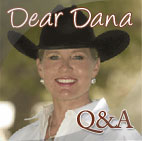The Gift of Horses
Since 1981, when Debi Ruth Parker blended passions for horses and working with the disabled, one thing has held true: When it’s R.E.I.N.S., love pours

Grace Shumate rides 'Rick' along with (from left) Amber Paciatto, Kristin Moore and Ingrid Mourey.
It’s here, on horseback, where gifts are exchanged all year long. Since 1981, the special students, their families, the horses, the staff, the volunteers–have enriched each other’s lives together at R.E.I.N.S., an acronym for Riding Emphasizing Individual Needs and Strengths.
“When people see this, they want to be part of it,” says Debbie Shinner, who arrived as a volunteer in 1992 and has been the Executive Director through 16 years of growth. “Just more and more students have been coming because they’ve heard. When parents find a therapy that works with their children or adults, they will travel to the moon and back.”
California-owned horse earns AQHA Most Valuable Western Horse title
Joe and Karen Moran's Vital Signs Are Good wins $5,000 check with Jason Martin, Charlie Cole
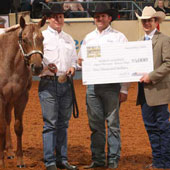
AQHA Senior Director of Publications Jim Bret Campbell (right) presents the Most Valuable Horse check to Jason Martin, Charlie Cole and Vital Signs Are Good.
Making the trip halfway across the country was more than worthwhile for many Californians, including Joe and Karen Moran of Laguna Hills. Their 9-year-old Vital Signs Are Good earned the distinguished title of Most Valuable Horse in Western Events at the 2009 AQHA World Show.
Since her 2-year-old western pleasure world championship in 2002, Vital Signs Are Good has been a familiar face in the winner’s circle of every AQHA World Show. The red roan mare by Zippos Mr Good Bar and out of a An Awesome Mister mare has won nine world championships and was the 2007 All Around Amateur with previous owner Kristen Galyean. Adding another notch to her belt, “Lucy” earned the Most Valuable Horse award in the Western division and a $5,000 check for new owners Joe and Karen Moran.
Richard Spooner, Apache take Los Angeles National Grand Prix
Junior/Amateur riders earn prestigious year-end medals
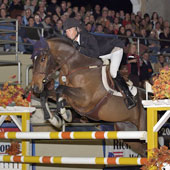
Richard Spooner and Apache win the $50,000 L.A. National World Cup Qualifier Grand Prix.
Grand Prix riders continued their indoor season in the $50,000 L.A. National Grand Prix, gaining valuable qualifying points for the 2010 World Cup Finals. Medal riders of all ages tested their technical skills in the Onondarka and West Coast Equestrian Medal Finals. Pre-Green horses strutted their stuff for possibly the last time before graduating to the First Year Green section next year.
Californian Maxance McManamy earns USEF Jr. Equestrian of the Year title
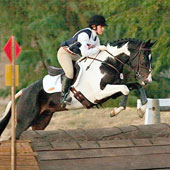
Maxance McManamy of Templeton, Calif., is the 2009 USEF Junior Equestrian of the Year.
The Ruth O’Keefe Meredith Trophy was established in 1985 to honor a junior equestrian who has made outstanding contributions to equestrian competition while exemplifying exceptional talent, sportsmanship and dedication. After reviewing the many candidates nominated for one of the USEF’s highest honors, the Awards Committee selected the young equestrian who exceeded the demanding qualification criteria.
McManamy, 18, from Templeton, Calif., is bringing positive attention to competition in the sport of Eventing. With consistent skill and maturity in the three disciplines of dressage, cross-county and show jumping, the numerous successes in her young career are quite notable.
The Five Easy Pieces: Exercises to take control of your horse’s body zones
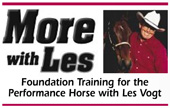 Continuing in a Series
Continuing in a Series
This time, we introduce the topic of Exercise No. 5: How this fits into the program. In the next few installments, Les Vogt takes you through exercises of his Five Easy Pieces. When you’ve mastered them, you should be able to put any part of your horse’s body where you want it, without resistance.
Exercise No. 5: How this fits into the program
When you can do Exercise No. 5 with ease, you’re going to have achieved control of every part of your horse, and that means you have the tools to both create good maneuvers and to fix faulty ones.
USHJA gives Lifetime Achievement Awards awards to Larry Langer and Joe Fargis
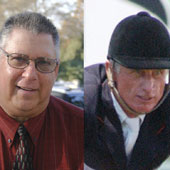
U.S. Hunter Jumper Association awards its 2009 Lifetime Achievement Awards to Larry Langer and Joe Fargis.
“Deciding the recipients of this award is never easy. Our industry is incredibly fortunate to have an abundance of people that have dedicated their lives to this sport, which makes a decision like this even harder,” USHJA President Bill Moroney said. “However, people like Joe Fargis and Larry Langer, who, in their own way, have been synonymous with dedication and achievement in our sport, are why we created this award.”
Dear Dana: What insight can you offer for stable selection for a first-timer?
DEAR DANA: My 6 year old niece loves horses and appears ready to jump into lessons. My sister is thrilled that I’m getting her involved. I may be putting too much pressure on myself, but I want to be sure her first experience is a good one. What insight can you offer for stable selection for a first-timer? Or, for that matter, the style of riding?
— Gina, Phoenix, Ariz.
DEAR GINA: It’s awesome that your niece loves horses and is excited! I am impressed that you are putting thought into how to get her started. It is important to give her a positive, safe experience. I strongly recommend that you are careful and thoughtful in your selection, as I am sure you will be. Anyone can hang a sign and say they are a horse trainer, but that does not mean that they are qualified or have experience and it does not mean that they have horses gentle and safe enough for a beginner. You need to investigate thoroughly and put your niece in the best hands possible! Here are some tips to selecting a stable:
First, decide if you want her to start English or western, as many stables will specialize in one or the other. I think that either style of riding is fine as long as your niece is learning from a qualified instructor and is put on extremely safe horses. I ride primarily western, so of course I would lean toward western riding. I also like the fact that the western saddle is larger and may offer more support. However, a qualified English riding stable with good horses and instructors is fine, too. Once you have made your decision as to the riding style, you can look into stables.
I show Quarter Horses and the American Quarter Horse Association offers referrals through the Professional Horseman’s Association. You can start there. The members of the Professional Horseman’s Association have to be qualified in some areas to be a member. If they can’t help you, they may be able to refer you to someone who can. Go and interview prospective stables. Look for signs of professionalism, such as cleanliness and good care of the horses. Also be sure to ask if they carry insurance. Get references from people who have taken lessons.
I also recommend you watch a lesson and see if you are comfortable with what you see. Safety is number one! I would ask what horse they are going to put your niece on. Quiz them about the safety of that horse. One bad experience can turn her away from horses forever. Make sure they go slow with her. Most riders on the first ride should only walk and, maybe in some cases, jog. Don’t let anything be rushed! Also, talk directly to the person giving the lesson to see if their personality style will work with your niece’s personality style. Really shy, timid kids may need an extremely encouraging, soft instructor. I have seen instructors that are negative and harsh. Stay away from them. Look for someone who will be positive, encouraging, and make it fun!
Short sessions are also better than a lesson that is held too long. Ideally, you want to end each lesson with her wanting more! I also recommend that the lesson program covers ground work and care for the horse on the ground with an emphasis on safety. I also like to see new riders taught on proper use of their hands, as well as exercises to improve their seat and balance!
I recommend that the first few lessons be private lessons. You want all the attention on your niece! Also look at the arena she will be riding in, is it quiet without a lot of chaos or uproar going on that could spook the horse? Is the ground good? Professionally run facilities are for the horse and the rider, and they are organized, neat, clean, and the ground is cared for in the arena.
I hope this helps you and best of luck to you and your niece!
Dana
P.S. – My Complete Guide DVD Series, including 101 Safety Tips, is perfect for you and your niece and will give you a lot of valuable information to have a positive start in horses!
Have your own question for Dana? If so, click here! If your question is used in “Dear Dana”, you will be entered into a monthly drawing for a FREE “Winning Strides” DVD!
Sign up for Dana’s newsletter and keep up with Dana’s updates, new products and clinic schedule! When you register, you are automatically entered into a quarterly raffle for great prizes, including a FREE personal training session with Dana! Click here to sign up now!
Honesty is the best only policy when evaluating your horse
HEY RAY!: I recently adopted a 5-year-old Thoroughbred mare off the track. She behaves well except when I put a saddle on. Then she gets antsy and walks on top of me and sometimes rears. But once the saddle is on, she’s fine. How do I get her to stop before she gets too dangerous?
— April Zimmerman, Aguanga, Calif.
HEY APRIL: Let me start by thanking you for creating a new home for a horse in need. As you probably already know, acquiring a horse — whether you adopt or buy — is the smaller part of the investment. The responsibility of figuring out what will be needed to make this commitment stick is where most of your efforts will go. If you truly want to be successful, you will have to be ruthlessly honest in the evaluation of your horse.
What concerns me about your question is that you seem to minimize the problem. You need to recognize that you have a horse that you should not trust in any situation until she learns to be sweet, willing and predictable (S.W.A.P.). It doesn’t matter whether the behavior is from fear, attitude, or both. Your horse needs to realize that as long as you’re with her, she has nothing to fear, regardless of the situation.
This feeling is something that you need to earn from your horse. I feel that the lesson of holding her ground can be better achieved by using anything that unsettles her other than the saddle, initially. That way if she had a bad experience before she learned the lesson, it wouldn’t be associated with the saddle. Remember, the only reason why the horse moves is because she hopes that, by doing so, she will leave the scary object behind (saddle, blanket, paper, bag, whip, etc.). Do not tie, or influence the horse by saying whoa or pulling on her to stop, during this process. The connection you have to the horse by the lead line, reins, etc. is simply to help you keep up with the horse while she’s figuring out her next move.
The most that you should represent to the horse at this moment is a ball and chain that she’ll have to deal with if she chooses to move. The freedom of choice to move is hers. Once the horse realizes that she is not getting hurt, but moving is not helping her, she will eventually stop. This will be a good time to introduce the saddle. Continue to put the saddle on and off over and over again until she doesn’t move before you cinch her up. This will be an important step in re-establishing the trust that will make her S.W.A.P.
If at any moment she becomes aggressive or threatening to you in any way, have her back up until she has a soft eye and reward her for the back-up. You should practice backing up and rewarding her before you establish this as the “Reward-able Exercise” while on the ground. We are looking for an excuse to reward her, so don’t forget that backing her up is not punishment for the aggressive behavior.
I truly believe that the reason your horse has a problem with the saddle is because of lack of preparation. I’m convinced that somebody put a saddle on your horse’s back before properly desensitizing her from movement, sound, and sensation. When going back and working on these things, make sure your horse is not just simply tolerant, but truly accepting. I’ve talked about this in previous Hey Ray columns.
April, I’m certain that if you follow these simple steps, not only will your mare perceive the saddle as being harmless, but she will appreciate the approach you have taken. If you don’t rush this process, it will take less time than you expect.
Always trust your instincts, and stay safe,
Ray
Horsetrader columnist Ray Ariss, husband to Pippa Ariss and father of six, shares his insight into the relationship of horseand human twice each month, in print and on www.horsetrader.com. He lives and trains in “Horsetown USA”, Norco, Calif., at his bustling Starbrite Riding Academy, where he currently has 50 horses in various stages of training, including Andalusians, Friesians, Quarter Horses, Paints, Thoroughbreds, Arabs, Mustangs and more. Ray attributes his training success to the support of his wife and partner, Pippa, and a system he calls S.W.A.P., to which he credits his multiple championships in several disciplines. His passionate understanding of the “human-horse” relationship was evident when he took on the challenge of training a wild Mustang and — in just 100 days — produced the highest-priced adopted Mustang ever — $50,000. Does your “horse-human relationship” leave you with a question for Ray? Click here to submit one!


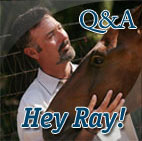
 Read Columns
Read Columns
